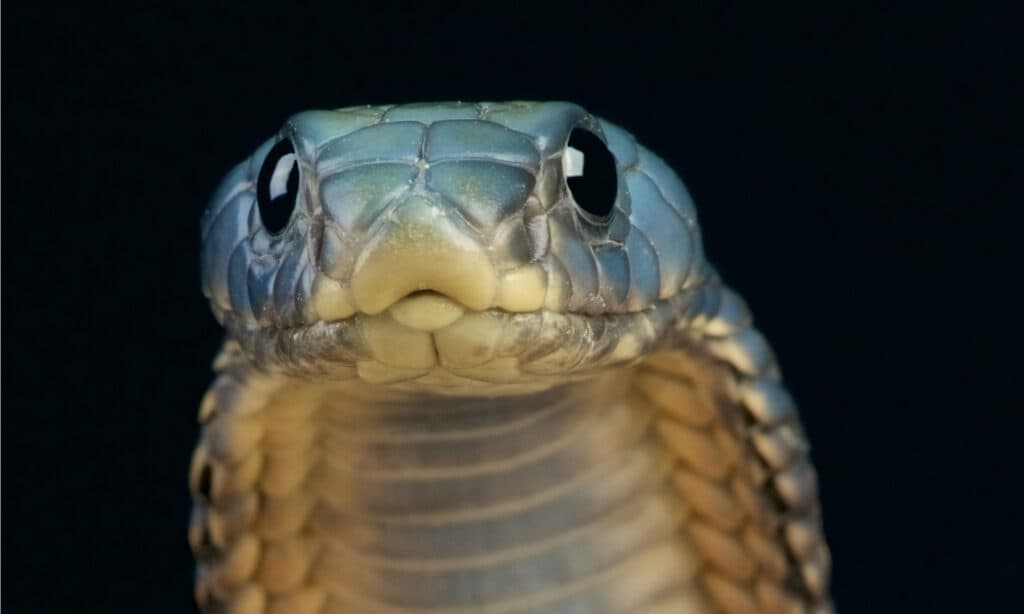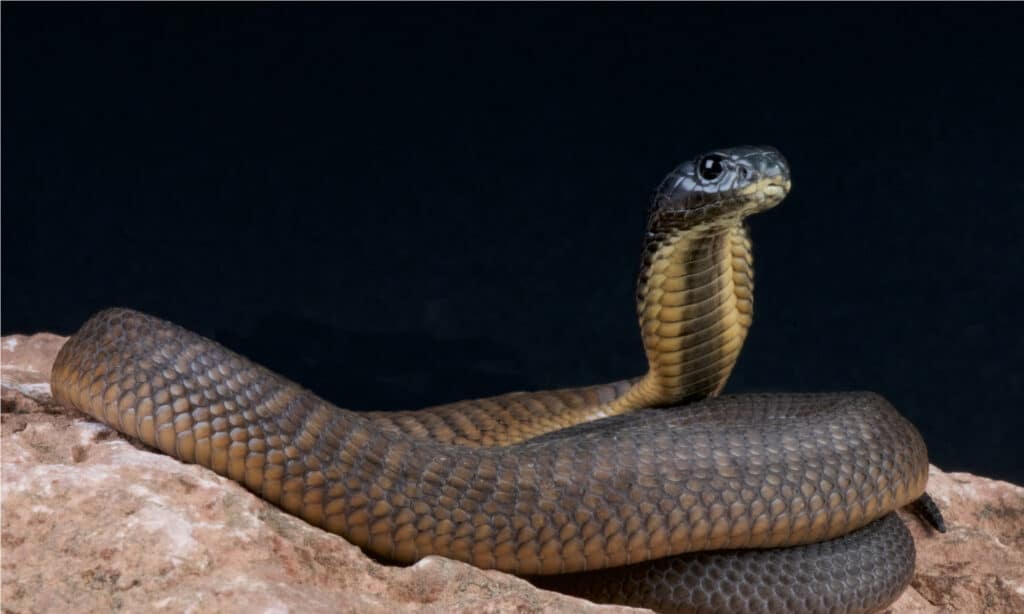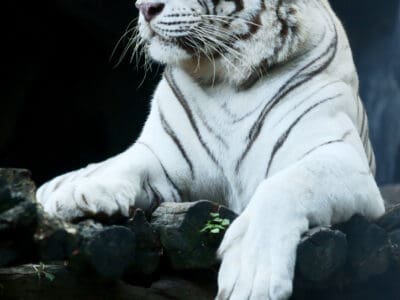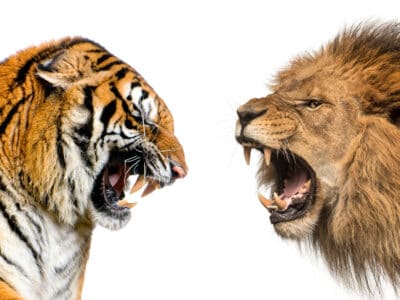Arabian Cobra
.jumbotron {
background-image: url(“https://a-z-animals.com/media/2022/05/Arabian-Cobra-header-400×300.jpg”);
}
}
@media only screen and (min-width: 641px) and (max-width: 920px) {
.jumbotron {
background-image: url(“https://a-z-animals.com/media/2022/05/Arabian-Cobra-header-470×370.jpg”);
}
}
@media only screen and (min-width: 921px) {
.jumbotron {
background-image: url(“https://a-z-animals.com/media/2022/05/Arabian-Cobra-header.jpg”);
}
}
Arabian Cobra
Naja arabica
The Arabian cobra is the only true cobra species that can be found in the Arabian Peninsula.
Arabian Cobra Scientific Classification
- Kingdom
- Animalia
- Phylum
- Chordata
- Class
- Reptilia
- Order
- Squamata
- Family
- Elapidae
- Genus
- Naja
- Scientific Name
- Naja arabica
Read our Complete Guide to Classification of Animals.
Arabian Cobra Conservation Status
Arabian Cobra Facts
- Prey
- Rodents and birds
- Fun Fact
- The Arabian cobra is the only true cobra species that can be found in the Arabian Peninsula.
- Litter Size
- Around 40 eggs
This post may contain affiliate links to our partners like Chewy, Amazon, and others. Purchasing through these helps us further the A-Z Animals mission to educate about the world’s species..

Discover alligator-eating snakes, spiders larger than your phone, and 1000 more incredible animals in our daily FREE email.
.photo-gallery {
–margin: 0px auto 0px;
–padding: 0px 0px 0px 0px;
}
.gallery-link {
background-image: url(“https://a-z-animals.com/media/2022/05/Arabian-Cobra-header-1024×614.jpg”);
background-repeat: no-repeat;
background-size: cover;
background-position: center;
height: 500px;
justify-content: center;
text-align: center;
align-items: center;
display: flex;
border: 2px solid #000;
}
.gallery-link img {
height: 50%;
}
@media only screen and (max-width: 768px) {
.gallery-link {
height: 300px !important;
}
}
View all of the Arabian Cobra images!
The Arabian cobra is the only true cobra species that can be found in the Arabian Peninsula.
Residing deep within one of the hottest ecosystems in the world, the Arabian cobra is rarely seen by people and remains elusive in the wild. They are considered to be extremely dangerous and have the ability to kill a person. This article will cover some interesting facts about the size, appearance, diet, and behavior of the Arabian cobra.
3 Arabian Cobra Amazing Facts
- The Arabian cobra had the distinction of being the 12,000th species added to National Geographic’s photo ark project. The photo ark aims to photograph many of the world’s animals, especially those in need of protection.
- Very few facts are known about this cobra’s reproductive behavior, but the female is thought to produce about 40 eggs at a time.
- The Arabian cobra flicks out its tongue to gather odor molecules in the air. It has an organ located on the roof of the mouth to sense these odors.
Where to Find Arabian Cobras
The Arabian cobra can be found in the deserts, hills, and plains throughout the western and southern portion of the Arabian Peninsula. It often forages during the day and lives in close proximity to a body of water. Some of the countries in which it resides include:
button.pulse {
transform: scale(1); animation: pulse 2s infinite;
box-shadow: 0 0 0 0 rgba(11, 247, 25, 1);
}
@keyframes pulse {
0% { transform: scale(0.90); box-shadow: 0 0 0 0 rgba(11, 247, 25, 0.5); }
60% { transform: scale(1); box-shadow: 0 0 0 15px rgba(11, 247, 25, 0); }
100% { transform: scale(0.90); box-shadow: 0 0 0 0 rgba(11, 247, 25, 0); }
}
Arabian Cobra Scientific Name
The scientific name of the Arabian cobra is Naja arabica. Naja is the Sanskrit word for snake (Sanskrit is a classical South Asian language). Arabica is the Latin form of Arabia. Until 2009, this snake was considered to be a subspecies of the closely related Egyptian cobra, which can be found throughout North Africa.
Arabian Cobra Population & Conservation Status
According to the IUCN Red List, the Arabian cobra is considered to be a species of least concern. Population numbers have never been properly estimated, but is it not known to face any significant threats in the wild. However, it is known to be exploited both for the purposes of venom extraction and the international exotic pet trade.
How to Identify the Arabian Cobra: Appearance and Description
The Arabian cobra is easy to identify from the solid gold, yellow, or light brown color of the body. Cervical ribs along the neck form the iconic hood for which the cobra is known. The Arabian cobra also has a triangular head and round, dark eyes. When fully grown, they are thought to measure up to 8 feet in size.
Here is how to identify the Arabian cobra:
- Long robust body measuring up to 8 feet in size
- Gold, yellow, or light brown body-color
- Prominent hood
- Round, dark eyes
Arabian Cobra Pictures

reptiles4all/Shutterstock.com

reptiles4all/Shutterstock.com
Arabian Cobra: How Dangerous Are They?
The venom of the Arabian cobra is considered to be highly toxic and dangerous. Its close relative, the Egyptian cobra, produces a potent mixture of neurotoxins (which attack the nerves) and cytotoxins (which attack normal cells). Symptoms of its bite may include pain, swelling, headaches, nausea, dizziness, necrosis, and even paralysis. Several deaths have been known to occur from its venom. The anti-venom is usually successful at stopping the victim’s condition from deteriorating even further if administered in time. It is not known how much venom they inject into the body at once, however.
Arabian Cobra Behavior and Humans
The Arabian cobra should never be approached in the wild. It is considered to be quite aggressive and dangerous toward people. When it is threatened, the snake will stand its ground, rear up, spread its hood, and hiss loudly. It may have a tendency to strike out and bite at any time. If you receive a bite, then you should seek out medical attention from a professional immediately.
View all 127 animals that start with A
Arabian Cobra FAQs (Frequently Asked Questions)
Are Arabian cobras venomous?
Yes, the Arabian cobra is considered to be highly venomous.
How do Arabian cobras hunt?
The hunting behavior of the Arabian cobra has not been properly documented, but if it’s anything like other cobras, then this snake is an active hunter that locates prey with its excellent sense of smell and good vision. After it strikes quickly, the potent venom is used to subdue the prey.
Are Arabian cobras aggressive?
Yes, the Arabian cobra is considered to be highly aggressive toward people.
Where do Arabian cobras live?
Arabian cobras live primarily in the deserts, hills, and plains of the Arabian Peninsula.
What do Arabian cobras eat?
Their diet is thought to consist almost entirely of rodents, birds, and other small animals.
Is the Arabian cobra deadly?
Yes, the venom does have the potential to kill a person in a single bite. However, accurate fatality numbers have never been gathered.
What colors are Arabian cobras?
The Arabian cobra is clothed in solid gold, yellow, or light brown colors. It does not have many markings over the body.
Sources
- National Geographic, Available here: https://www.nationalgeographic.com/animals/article/arabian-cobra-milestone-species-in-photo-ark
- National Geographic, Available here: https://blog.nationalgeographic.org/2021/11/16/arabian-cobra-joins-national-geographic-photo-ark-as-the-12000th-species/
- Clinical Toxinology Resources, Available here: http://www.toxinology.com/fusebox.cfm?fuseaction=main.snakes.display&id=SN0232
- IUCN Redlist, Available here: https://www.iucnredlist.org/species/199850/2613995
















